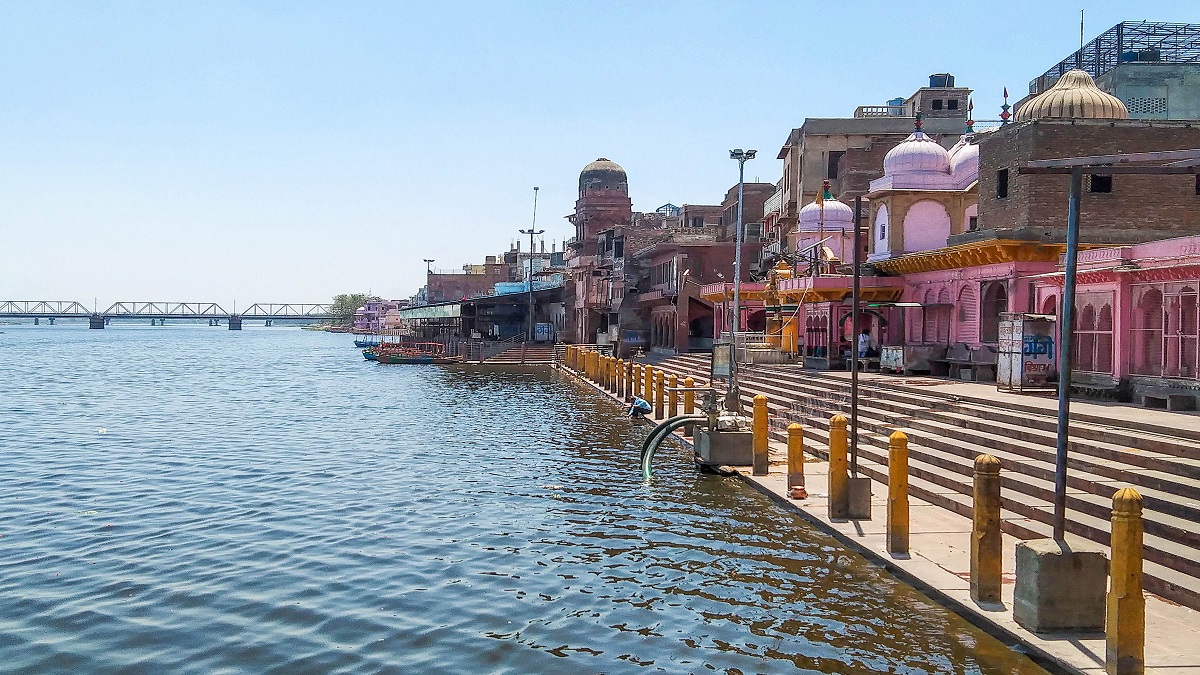– By Brij Khandelwal
Elections come and go but one sordid reality that does not change for the better is the condition of the Yamuna River and its tributaries in the Agra region (Braj area) once revered as the Sri Krishna land.
The sitting MP from Mathura, cine star turned politician Hema Malini, has promised action in her next term. For the ten years that she represented Mathura, she did precious little to restore the original glory of Yamuna.
In Agra, both the sitting MPs of the ruling party, Prof SP Singh Baghael, and Raj Kumar Chahar, have not even bothered to refer to the deplorable condition of water bodies and river Yamuna in particular. The eco-sensitive Taj Trapezium Zone, despite a slew of measures at the intervention of the apex court, continues to battle all forms of pollution.
Due to the dry and polluted Yamuna, the 17th-century monument of love, the Taj Mahal is a victim of dust and heat. “Each year we have been watching colonies of green bacteria, defiling the white marble surface of the Taj Mahal. The cesspools in the dry Yamuna have become the breeding grounds of bacteria and mosquitoes,” says tourist guide Ved Prakash Gautam.
“We had expected that the manifestoes of political parties would make specific reference to Yamuna and other rivers of India that need urgent remedial measures to save them from degenerating into sewage canals. We have been demanding a national rivers policy for a long time, to address challenges that our rivers face. Still, sadly politicians have generally ignored environmental issues,” said environmentalist Devashish Bhattacharya of the River Connect Campaign.
Agra has for decades been demanding a barrage downstream of the Taj Mahal to store monsoon rains to contain the high SPM (suspended particulate matter) level, absorb noxious gases from increased emissions from automobiles, and bring down the temperature in peak summer, besides providing a picturesque riverfront dotted with Mughal monuments in Agra, say the river activists.
It’s not just one river but almost all the rivers in India that are giving alarming signals but political parties have not drawn up long-term plans for their rejuvenation, even though it is widely recognized that the rivers have been sustaining life in their various manifestations and glory. The importance of rivers in India can be understood by one simple fact almost all rivers are worshipped as goddesses.
It may be mentioned that the river Yamuna, the consort of Sri Krishna has played a significant role in shaping the history of India right from the days of the Mahabharat till today. An interesting fact about Yamuna is that it has a richer history and has made a more valuable contribution to enriching culture, art, architecture, and commerce, compared to the river Ganga.
Starting in Uttarkashi district in the Himalayas from Yamunotri glacier, it enters Dehradoon, flows close to Jagdhari and Yamuna Nagar in Himachal, separates UP and Haryana, enters Saharanpur in UP, touches Kurukshetra, Karnal, Sonipat, and the famous battleground of Panipat. The epic Mahabharata was written on its bank, Saint Parasher, and Satyawati gave birth to Ved Vyas, Raja Bharat and the father of Bhisma Shantanu organized great Yagnas, and for thousands of years great saints and thinkers lived in ashrams along the Yamuna banks.
In the Agra district, Yamuna is joined by half a dozen other smaller rivers like Parvati, Khari, Utangan, and Gambhir. Beyond Agra rivers, Betwa and Chambal merge into Yamuna which eventually joins Ganga in Allahabad.
How do we describe Yamuna today? A sewage canal, a drain, a big gutter, a civilisational sink? From the life-giving Amrit to death dispensing poison, has been the cruel tale of this river which even in its dying stage is sustaining the life of millions of people.
In three decades, the state and the central governments have spent crores of rupees to implement a variety of Action Plans but the results don’t match the efforts. The water of both the Yamuna and the Ganga is unfit for human consumption due to pollution from industries and open drains that daily discharge millions of gallons of untreated liquid from Haryana to Agra.
So many expert committees have said that the quality of water in the Yamuna River has not shown the desired improvement, particularly in Delhi, due to the enormous increase in pollution load and lack of fresh water in the river during (the) lean period. Frequent deaths of fish in Agra and Mathura ring the alarm bells but action is lacking, say the locals.
The city of the Taj is heavily dependent on Yamuna raw water, but unfortunately despite a series of ambitious schemes and the direct intervention of the Supreme Court the government agencies have dismally failed to prevent river pollution.
Indeed when the devouts enter the Yamuna for a ritualistic dip and “achman” on festivals, they never fail to have “sakshat darshan” of Kali Naag in the form of pollution.













